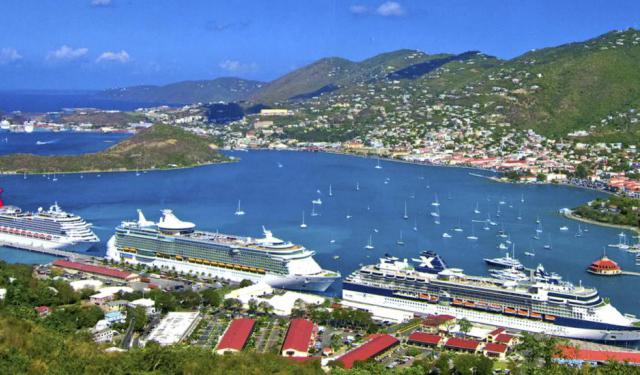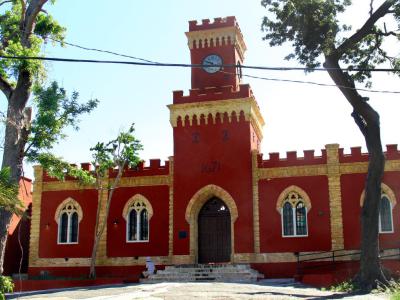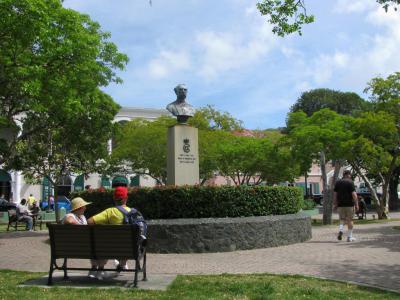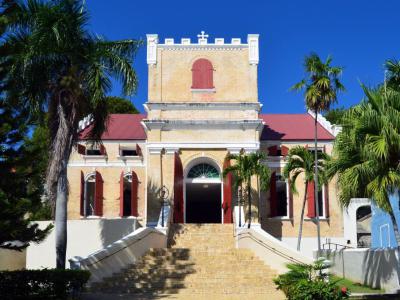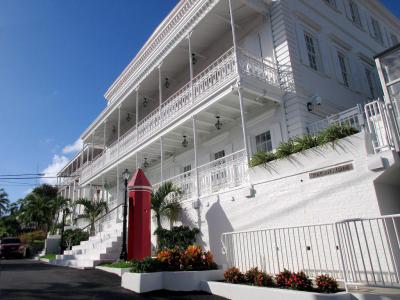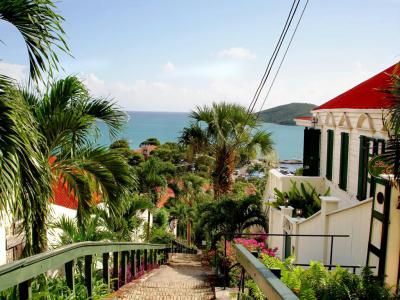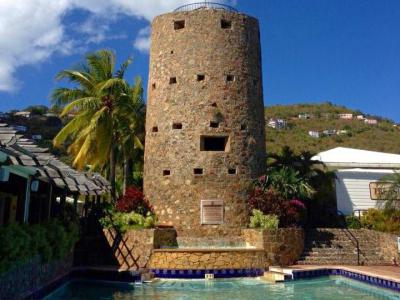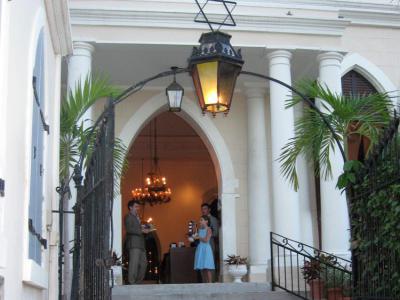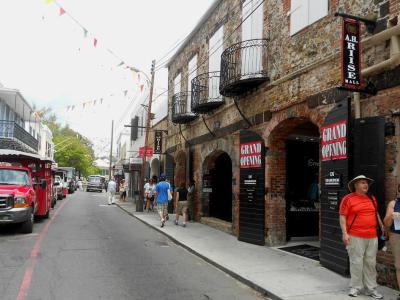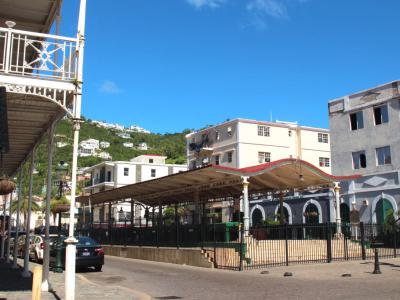Audio Guide: Charlotte Amalie Introduction Walking Tour (Self Guided), Charlotte Amalie
Once a haven for pirates, the capital city of the United States Virgin Islands, Charlotte Amalie, is now one of the busiest ports of call for cruise ships in the Caribbean, receiving annually almost 1.5 million visitors.
This area has been inhabited for centuries. When Christopher Columbus arrived here in 1493, it was populated by Caribs, Arawaks, Ciboney, and Taíno native tribes. The town founded by the Danes in 1666, originally known as Taphus (meaning 'tap house' or 'beer hall' in Danish), was renamed in 1691 after the queen-consort of Denmark, Charlotte Amalie of Hesse-Kassel.
In the 17th century, the Danes built both Blackbeard's Castle and Bluebeard's Castle, legendary lookouts frequented by pirates. In the early 1800s, Charlotte Amalie thrived as a crucial hub in the West Indian trade but faced devastating fires, leading to a decline in its commercial significance. Despite its challenges, during the American Civil War, the town became a bustling smuggling center.
A cholera epidemic caused an economic downturn that lasted until the United States purchased the islands from Denmark in 1917, revitalizing their prospects. Having been established as the capital of the US Virgin Islands, the city briefly, from 1921 to 1936, went by the name Saint Thomas before it was finally recognized as Charlotte Amalie.
Following the 1960s, Charlotte Amalie experienced a surge in tourism, becoming a popular destination for mainland US citizens seeking luxury vacations or second homes in the Caribbean. This influx of visitors led to significant economic growth, driving the transformation of historic buildings into restaurants and shops, while hilltop homes overlooking the pristine Caribbean waters became a prominent feature of the landscape.
Aside from its distinctive Danish colonial architecture, the city has dozens of streets and places still bearing Danish names. Among its historically important buildings are the likes of Saint Thomas Synagogue, the second oldest synagogue in the United States, and Frederick Lutheran Church. Other tourist attractions include the 17th-century Fort Christian, the oldest standing structure in the Virgin Islands Archipelago, the historic 99 Steps Stairway crafted from ballast bricks, and the Emancipation Garden with a copy of the Liberty Bell and a freed slave blowing a conch shell statue – a source of national pride.
For all who venture into Charlotte Amalie, this enchanting city promises an unforgettable experience filled with historic landmarks, culinary delights, and the sun-kissed beauty of the Caribbean. To make the most of your time in Charlotte Amalie, take our self-guided walk and create memories that will last you a lifetime!
This area has been inhabited for centuries. When Christopher Columbus arrived here in 1493, it was populated by Caribs, Arawaks, Ciboney, and Taíno native tribes. The town founded by the Danes in 1666, originally known as Taphus (meaning 'tap house' or 'beer hall' in Danish), was renamed in 1691 after the queen-consort of Denmark, Charlotte Amalie of Hesse-Kassel.
In the 17th century, the Danes built both Blackbeard's Castle and Bluebeard's Castle, legendary lookouts frequented by pirates. In the early 1800s, Charlotte Amalie thrived as a crucial hub in the West Indian trade but faced devastating fires, leading to a decline in its commercial significance. Despite its challenges, during the American Civil War, the town became a bustling smuggling center.
A cholera epidemic caused an economic downturn that lasted until the United States purchased the islands from Denmark in 1917, revitalizing their prospects. Having been established as the capital of the US Virgin Islands, the city briefly, from 1921 to 1936, went by the name Saint Thomas before it was finally recognized as Charlotte Amalie.
Following the 1960s, Charlotte Amalie experienced a surge in tourism, becoming a popular destination for mainland US citizens seeking luxury vacations or second homes in the Caribbean. This influx of visitors led to significant economic growth, driving the transformation of historic buildings into restaurants and shops, while hilltop homes overlooking the pristine Caribbean waters became a prominent feature of the landscape.
Aside from its distinctive Danish colonial architecture, the city has dozens of streets and places still bearing Danish names. Among its historically important buildings are the likes of Saint Thomas Synagogue, the second oldest synagogue in the United States, and Frederick Lutheran Church. Other tourist attractions include the 17th-century Fort Christian, the oldest standing structure in the Virgin Islands Archipelago, the historic 99 Steps Stairway crafted from ballast bricks, and the Emancipation Garden with a copy of the Liberty Bell and a freed slave blowing a conch shell statue – a source of national pride.
For all who venture into Charlotte Amalie, this enchanting city promises an unforgettable experience filled with historic landmarks, culinary delights, and the sun-kissed beauty of the Caribbean. To make the most of your time in Charlotte Amalie, take our self-guided walk and create memories that will last you a lifetime!
How it works: Download the app "GPSmyCity: Walks in 1K+ Cities" from Apple App Store or Google Play Store to your mobile phone or tablet. The app turns your mobile device into a personal tour guide and its built-in GPS navigation functions guide you from one tour stop to next. The app works offline, so no data plan is needed when traveling abroad.
Charlotte Amalie Introduction Walking Tour Map
Guide Name: Charlotte Amalie Introduction Walking Tour
Guide Location: US Virgin Island » Charlotte Amalie (See other walking tours in Charlotte Amalie)
Guide Type: Self-guided Walking Tour (Sightseeing)
# of Attractions: 9
Tour Duration: 1 Hour(s)
Travel Distance: 2.2 Km or 1.4 Miles
Author: DanaOffice
Sight(s) Featured in This Guide:
Guide Location: US Virgin Island » Charlotte Amalie (See other walking tours in Charlotte Amalie)
Guide Type: Self-guided Walking Tour (Sightseeing)
# of Attractions: 9
Tour Duration: 1 Hour(s)
Travel Distance: 2.2 Km or 1.4 Miles
Author: DanaOffice
Sight(s) Featured in This Guide:
- Fort Christian
- Emancipation Garden
- Frederick Evangelical Lutheran Church
- Government House
- 99 Steps
- Blackbeard’s Castle
- St. Thomas Synagogue
- Main Street
- Market Square
1) Fort Christian (must see)
Fort Christian was constructed between 1672 and 1680 during the early stages of European colonization. Built by the Dano-Norwegian authorities, the fort served as a central hub for defense and governance, remaining active through both Dano-Norwegian and Danish rule until 1917, when the United States acquired the Virgin Islands.
The original design of Fort Christian included thick stone curtain walls with diamond-shaped bastions at each corner. Ravelins once reinforced the north, east, and west sides, while a circular stone tower originally stood at the center. This central tower was removed in the 19th century and replaced with the Gothic Revival structure that visitors see today. The fort’s layout reflects its strategic importance in protecting the island and managing colonial affairs.
Recognized for its historical and cultural significance, Fort Christian was designated a U.S. National Historic Landmark in 1977. It remains one of the oldest and most historically important structures in the Virgin Islands.
Today, visitors can explore the fort’s walls, examine its defensive features, and view exhibits detailing the island’s colonial past. Fort Christian provides insight into Saint Thomas’s European colonization, military history, and governance, offering an educational experience for tourists.
The original design of Fort Christian included thick stone curtain walls with diamond-shaped bastions at each corner. Ravelins once reinforced the north, east, and west sides, while a circular stone tower originally stood at the center. This central tower was removed in the 19th century and replaced with the Gothic Revival structure that visitors see today. The fort’s layout reflects its strategic importance in protecting the island and managing colonial affairs.
Recognized for its historical and cultural significance, Fort Christian was designated a U.S. National Historic Landmark in 1977. It remains one of the oldest and most historically important structures in the Virgin Islands.
Today, visitors can explore the fort’s walls, examine its defensive features, and view exhibits detailing the island’s colonial past. Fort Christian provides insight into Saint Thomas’s European colonization, military history, and governance, offering an educational experience for tourists.
2) Emancipation Garden
Emancipation Garden holds profound significance, named in commemoration of the emancipation of slaves by Danish Governor Peter von Scholten on July 3rd, 1848. This historical event marked a pivotal moment in the struggle for freedom and human rights. The park offers a tranquil retreat, shaded by a canopy of trees that provide a perfect setting for relaxation and reflection. Throughout the year, Emancipation Garden becomes a vibrant hub for special events, most notably the annual Emancipation Day festivities.
A prominent feature in the park is the Conch Shell Blower statue, situated on the west side. Symbolizing a newly freed slave, this statue encapsulates the theme of liberation and stands as a poignant reminder of the struggles endured by those who sought freedom. As part of ongoing renovations related to the Veteran’s Drive – Waterfront expansion, the statue is set to be moved to a more prominent location, ensuring its significance is recognized and appreciated by all who visit.
Emancipation Garden is not only a site of historical remembrance but also a repository of symbolic monuments. One such notable feature is the reproduction of the Liberty Bell, a testament to the universal ideals of freedom and equality. Many may be surprised to learn that each state and U.S. territory was presented with a replica of this iconic bell, and the Virgin Islands proudly displays its own in the heart of Emancipation Garden.
Directly beneath the Liberty Bell replica, a plaque presented by the Commonwealth of Virginia adds another layer of historical depth. The plaque commemorates the "Landing of Virginia Settlers" on April 4, 1607, when 144 English travelers bound for Virginia took refuge in the Virgin Islands. This event marked the founding of Jamestown, the first permanent English settlement beyond the British Isles, initiating the overseas expansion of English-speaking people.
A prominent feature in the park is the Conch Shell Blower statue, situated on the west side. Symbolizing a newly freed slave, this statue encapsulates the theme of liberation and stands as a poignant reminder of the struggles endured by those who sought freedom. As part of ongoing renovations related to the Veteran’s Drive – Waterfront expansion, the statue is set to be moved to a more prominent location, ensuring its significance is recognized and appreciated by all who visit.
Emancipation Garden is not only a site of historical remembrance but also a repository of symbolic monuments. One such notable feature is the reproduction of the Liberty Bell, a testament to the universal ideals of freedom and equality. Many may be surprised to learn that each state and U.S. territory was presented with a replica of this iconic bell, and the Virgin Islands proudly displays its own in the heart of Emancipation Garden.
Directly beneath the Liberty Bell replica, a plaque presented by the Commonwealth of Virginia adds another layer of historical depth. The plaque commemorates the "Landing of Virginia Settlers" on April 4, 1607, when 144 English travelers bound for Virginia took refuge in the Virgin Islands. This event marked the founding of Jamestown, the first permanent English settlement beyond the British Isles, initiating the overseas expansion of English-speaking people.
3) Frederick Evangelical Lutheran Church
The Frederick Evangelical Lutheran Church, established in 1666, coincided with the formal possession of Saint Thomas under the Danish West Indies Company. As the Danish state religion, Lutheranism was integral to the colony’s development, mandated under the Danish West Indies Company's charter. When Saint Thomas became a crown colony in 1754, the church expanded its community role, operating schools for both Lutheran and enslaved children.
Frederick church freed its enslaved workers in 1845, preceding the general emancipation in 1848. Worship services evolved linguistically over time, transitioning from Danish and Creole to English, with Danish services ceasing in the 1930s.
The church’s present building, constructed between 1789 and 1793, was financed through donations, government contributions, and loans. After a fire in 1826 and hurricane damage in 1870, it was rebuilt and remodeled, adding a tower and church bell in 1871. Further renovations in the 20th century included a vestry and sacristy, with local mahogany used in the chancel and pulpit.
The Bethania Mission Hall, inaugurated in 1908, served as a Sunday school, parish hall, and briefly, a home for elderly parishioners. The historic parsonage at 23 Kongens Gade, over 250 years old, is one of the island's oldest structures. Built with Danish bricks and stones, it retains historical features, including chimneys and a slave cell in the courtyard. The church's enduring legacy reflects its central role in Saint Thomas’s religious, educational, and cultural history.
Frederick church freed its enslaved workers in 1845, preceding the general emancipation in 1848. Worship services evolved linguistically over time, transitioning from Danish and Creole to English, with Danish services ceasing in the 1930s.
The church’s present building, constructed between 1789 and 1793, was financed through donations, government contributions, and loans. After a fire in 1826 and hurricane damage in 1870, it was rebuilt and remodeled, adding a tower and church bell in 1871. Further renovations in the 20th century included a vestry and sacristy, with local mahogany used in the chancel and pulpit.
The Bethania Mission Hall, inaugurated in 1908, served as a Sunday school, parish hall, and briefly, a home for elderly parishioners. The historic parsonage at 23 Kongens Gade, over 250 years old, is one of the island's oldest structures. Built with Danish bricks and stones, it retains historical features, including chimneys and a slave cell in the courtyard. The church's enduring legacy reflects its central role in Saint Thomas’s religious, educational, and cultural history.
4) Government House
The Government House, standing proudly atop Government Hill, is the administrative center for the governor of the U.S. Virgin Islands and his staff. It is also a captivating historical and cultural landmark. The neoclassical, white, three-story building showcases beautifully intricate ironwork along its balconies. Originally constructed by the Danes between 1865 and 1867, it has witnessed the unfolding history of the islands and has been an integral part of Charlotte Amalie's architectural and civic landscape.
The outside elegance of the house is matched on the inside by the mahogany staircases. The interior is adorned with plaques honoring each of the territory's governors throughout its history. This gallery of plaques serves as a chronological journey through the leadership of the U.S. Virgin Islands, showcasing the diverse and evolving narratives that have shaped the region.
The cultural richness of the Government House extends beyond administrative memorabilia, though. The presence of artworks by renowned artist, Camille Pissarro, a native of Saint Thomas, adds an additional layer of artistic allure to the building.
Complementing this outside is a breathtaking panorama of Charlotte Amalie's picturesque waterfront and colorful architecture. The strategic location on Government Hill allows for an expansive view and makes it a wonderful place to visit.
The outside elegance of the house is matched on the inside by the mahogany staircases. The interior is adorned with plaques honoring each of the territory's governors throughout its history. This gallery of plaques serves as a chronological journey through the leadership of the U.S. Virgin Islands, showcasing the diverse and evolving narratives that have shaped the region.
The cultural richness of the Government House extends beyond administrative memorabilia, though. The presence of artworks by renowned artist, Camille Pissarro, a native of Saint Thomas, adds an additional layer of artistic allure to the building.
Complementing this outside is a breathtaking panorama of Charlotte Amalie's picturesque waterfront and colorful architecture. The strategic location on Government Hill allows for an expansive view and makes it a wonderful place to visit.
5) 99 Steps (must see)
The 99 Steps stand as a unique and picturesque architectural feature that has become synonymous with the historical charm of the city. These step streets, known as "frigangs" by the Danes, were constructed in the mid-1700s. While numerous step streets traverse the hills rising from the harbor area, the 99 Steps hold a special place as one of the most popular and frequently photographed stairways in the city.
The allure of the 99 Steps lies not only in their historical significance but also in their aesthetic appeal. The bricks used in the construction of the steps were brought from Denmark, serving as ballast in the hulls of sailing ships that traversed the Atlantic. This historical detail adds a layer of authenticity to the steps, connecting them to the maritime history of the region.
Despite their name, the 99 Steps are a bit of a misnomer, as the stairway actually comprises 103 steps. The discrepancy in the count doesn't diminish the charm of this architectural gem, which has retained its original name of Store Taarne Gade, translating to Greater Tower Street.
The allure of the 99 Steps lies not only in their historical significance but also in their aesthetic appeal. The bricks used in the construction of the steps were brought from Denmark, serving as ballast in the hulls of sailing ships that traversed the Atlantic. This historical detail adds a layer of authenticity to the steps, connecting them to the maritime history of the region.
Despite their name, the 99 Steps are a bit of a misnomer, as the stairway actually comprises 103 steps. The discrepancy in the count doesn't diminish the charm of this architectural gem, which has retained its original name of Store Taarne Gade, translating to Greater Tower Street.
6) Blackbeard’s Castle (must see)
Blackbeard’s Castle, part of the Skytsborg Historical Park complex, is one of St. Thomas’s most recognizable landmarks. Combining history and legend, the site blends its authentic colonial past with a light touch of pirate-themed charm. Statues of famous buccaneers and occasional costumed interpreters make it fun for families, while the preserved architecture and scenic setting appeal to those interested in history and culture.
At the center of the site stands the stone Skytsborg Tower, often called Blackbeard’s Tower. Built by the Danes in 1679 as a watchtower to guard Charlotte Amalie Harbor, it was later designated a U.S. National Historic Landmark. Though the connection to the infamous pirate Blackbeard (Edward Teach) is unproven, local legend claims he once used the tower as a lookout—an idea that continues to fuel its mystery and appeal.
The tower’s solid construction and elevated position reflect the strategic purpose it served during the island’s colonial period. Visitors can climb to the top for sweeping views of the harbor and surrounding hills, gaining a sense of the vantage point that once helped protect the town below.
The broader complex enhances the visit with landscaped paths, restored buildings, and leisure amenities. A pool and bar provide spaces to relax after touring the grounds, offering a comfortable mix of history and hospitality. Combining panoramic views, colonial architecture, and the enduring allure of pirate tales, Blackbeard’s Castle remains a distinctive stop for anyone exploring the history of St. Thomas.
At the center of the site stands the stone Skytsborg Tower, often called Blackbeard’s Tower. Built by the Danes in 1679 as a watchtower to guard Charlotte Amalie Harbor, it was later designated a U.S. National Historic Landmark. Though the connection to the infamous pirate Blackbeard (Edward Teach) is unproven, local legend claims he once used the tower as a lookout—an idea that continues to fuel its mystery and appeal.
The tower’s solid construction and elevated position reflect the strategic purpose it served during the island’s colonial period. Visitors can climb to the top for sweeping views of the harbor and surrounding hills, gaining a sense of the vantage point that once helped protect the town below.
The broader complex enhances the visit with landscaped paths, restored buildings, and leisure amenities. A pool and bar provide spaces to relax after touring the grounds, offering a comfortable mix of history and hospitality. Combining panoramic views, colonial architecture, and the enduring allure of pirate tales, Blackbeard’s Castle remains a distinctive stop for anyone exploring the history of St. Thomas.
7) St. Thomas Synagogue (must see)
Constructed in 1833 on the same grounds as its predecessors, the Saint Thomas Synagogue is a beacon of religious and historical significance, making it the second-oldest synagogue in the Western Hemisphere and the oldest continuously used synagogue under the American flag.
Approaching the Saint Thomas Synagogue, visitors are greeted by a front courtyard that adds a sense of reverence to the entry. The temple's pediment is supported by brick pillars with Tuscan styling, contributing to the dignified and welcoming ambiance of the space.
The single-story structure is a remarkable example of architectural resilience, built from rubblestone held together by a mortar mix of lime, sand, and molasses. Topped with a shallow pitch hip roof, the synagogue's façade presents a fascinating blend of architectural styles. While the front features a Greek Revival temple, the arched window openings showcase elements of Gothic Revival, creating a distinctive and harmonious aesthetic.
Inside the synagogue, the Torah ark takes center stage on the east wall, while the tevah is positioned on a dais against the west wall. The interior design reflects a thoughtful layout, with a square of four Ionic columns demarcating the center of the chamber. Movable wooden partitions separate the seating areas for men and women, maintaining a tradition of modesty and respect within the congregation. The synagogue boasts a domed ceiling adorned with beautiful chandeliers, mahogany pews, and sand floors, creating an atmosphere of timeless elegance.
In 1997, the Saint Thomas Synagogue was rightfully designated a National Historic Landmark, recognizing its architectural significance and historical importance. Adjacent to the synagogue, the Weibel Museum offers visitors an immersive journey through over 200 years of Jewish life in Saint Thomas, further enriching the cultural and historical tapestry of the region.
Approaching the Saint Thomas Synagogue, visitors are greeted by a front courtyard that adds a sense of reverence to the entry. The temple's pediment is supported by brick pillars with Tuscan styling, contributing to the dignified and welcoming ambiance of the space.
The single-story structure is a remarkable example of architectural resilience, built from rubblestone held together by a mortar mix of lime, sand, and molasses. Topped with a shallow pitch hip roof, the synagogue's façade presents a fascinating blend of architectural styles. While the front features a Greek Revival temple, the arched window openings showcase elements of Gothic Revival, creating a distinctive and harmonious aesthetic.
Inside the synagogue, the Torah ark takes center stage on the east wall, while the tevah is positioned on a dais against the west wall. The interior design reflects a thoughtful layout, with a square of four Ionic columns demarcating the center of the chamber. Movable wooden partitions separate the seating areas for men and women, maintaining a tradition of modesty and respect within the congregation. The synagogue boasts a domed ceiling adorned with beautiful chandeliers, mahogany pews, and sand floors, creating an atmosphere of timeless elegance.
In 1997, the Saint Thomas Synagogue was rightfully designated a National Historic Landmark, recognizing its architectural significance and historical importance. Adjacent to the synagogue, the Weibel Museum offers visitors an immersive journey through over 200 years of Jewish life in Saint Thomas, further enriching the cultural and historical tapestry of the region.
8) Main Street
Main Street, the bustling thoroughfare that commences at Post Office Square, stands as the vibrant heart of Charlotte Amalie, offering a captivating blend of commerce, history, and duty-free shopping. Known as Dronningens Gade in Danish, translating to Queen's Street, Main Street is the primary artery running through the historic city.
Lined on both sides with an array of retailers, Main Street is a shopping haven, showcasing duty-free bargains that appeal to cruise ship passengers and resort guests alike. The street is a dynamic mix of commerce, with shops ranging from global brands like Tommy Hilfiger outlets to specialized establishments such as liquor emporiums and chocolate shops.
As one strolls along Main Street, the architectural diversity becomes apparent. On the south side, buildings stand in long stretches, separated by narrow alleys that once served as warehouses during the height of trade activity. On the north side of Main Street, a collection of 18th and 19th-century classic West Indian buildings and former town houses paint a picture of the city's colonial heritage. These square-shaped structures, many with two stories and balconies, have been repurposed over time. In the past, the first floor housed shops, while the second floor served as the residence for shopkeepers. Today, these historic buildings are home to duty-free shops, breathing new life into their storied walls.
In addition to its commercial offerings, Main Street embraces a cultural and culinary scene with popular cafes like Gladys' Café and Amalia Cafe. For those seeking authentic local arts and crafts, the Native Arts and Crafts Cooperative and Vendor's Plaza on the side streets and fringes of downtown provide a delightful detour.
Lined on both sides with an array of retailers, Main Street is a shopping haven, showcasing duty-free bargains that appeal to cruise ship passengers and resort guests alike. The street is a dynamic mix of commerce, with shops ranging from global brands like Tommy Hilfiger outlets to specialized establishments such as liquor emporiums and chocolate shops.
As one strolls along Main Street, the architectural diversity becomes apparent. On the south side, buildings stand in long stretches, separated by narrow alleys that once served as warehouses during the height of trade activity. On the north side of Main Street, a collection of 18th and 19th-century classic West Indian buildings and former town houses paint a picture of the city's colonial heritage. These square-shaped structures, many with two stories and balconies, have been repurposed over time. In the past, the first floor housed shops, while the second floor served as the residence for shopkeepers. Today, these historic buildings are home to duty-free shops, breathing new life into their storied walls.
In addition to its commercial offerings, Main Street embraces a cultural and culinary scene with popular cafes like Gladys' Café and Amalia Cafe. For those seeking authentic local arts and crafts, the Native Arts and Crafts Cooperative and Vendor's Plaza on the side streets and fringes of downtown provide a delightful detour.
9) Market Square
Market Square's historical significance harks back to a darker chapter when it served as one of the busiest slave markets in the West Indies during the 18th century. Officially known as Rothschild Francis Square, it has evolved into a lively marketplace where people from all corners of the island gather to engage in the buying and selling of fresh produce, fish, sauces, and vegetables. Over time, however, Market Square underwent a metamorphosis, shedding its painful past to become a central place for community commerce.
At the heart of Market Square stands an imposing cast iron bungalow, constructed in the early 20th century, which serves as the focal point for vendors to set up their stalls. This architectural landmark adds a sense of character to the square, becoming a gathering place for locals and a point of interest for visitors exploring the cultural tapestry of Charlotte Amalie.
Saturday emerges as the busiest market day at Market Square, a tradition that has stood the test of time. Vendors arrive well before dawn, setting up their stalls to offer a variety of fresh and locally sourced goods. The atmosphere on Saturdays reflects a vibrant and bustling energy, reminiscent of farmers markets found across the globe. For tourists who venture to Market Square on Saturday mornings, the experience is a reminder of the diverse and communal spirit that permeates marketplaces worldwide.
Accessing Market Square is made convenient through Main Street, allowing visitors to seamlessly transition from the shopping districts to the lively and colorful atmosphere of the square. The square not only serves as a place for commerce but also as a cultural melting pot where the community comes together to celebrate the richness of local produce and the shared experiences of daily life.
At the heart of Market Square stands an imposing cast iron bungalow, constructed in the early 20th century, which serves as the focal point for vendors to set up their stalls. This architectural landmark adds a sense of character to the square, becoming a gathering place for locals and a point of interest for visitors exploring the cultural tapestry of Charlotte Amalie.
Saturday emerges as the busiest market day at Market Square, a tradition that has stood the test of time. Vendors arrive well before dawn, setting up their stalls to offer a variety of fresh and locally sourced goods. The atmosphere on Saturdays reflects a vibrant and bustling energy, reminiscent of farmers markets found across the globe. For tourists who venture to Market Square on Saturday mornings, the experience is a reminder of the diverse and communal spirit that permeates marketplaces worldwide.
Accessing Market Square is made convenient through Main Street, allowing visitors to seamlessly transition from the shopping districts to the lively and colorful atmosphere of the square. The square not only serves as a place for commerce but also as a cultural melting pot where the community comes together to celebrate the richness of local produce and the shared experiences of daily life.
Sight description based on Wikipedia.
The Most Popular Cities
/ view all
